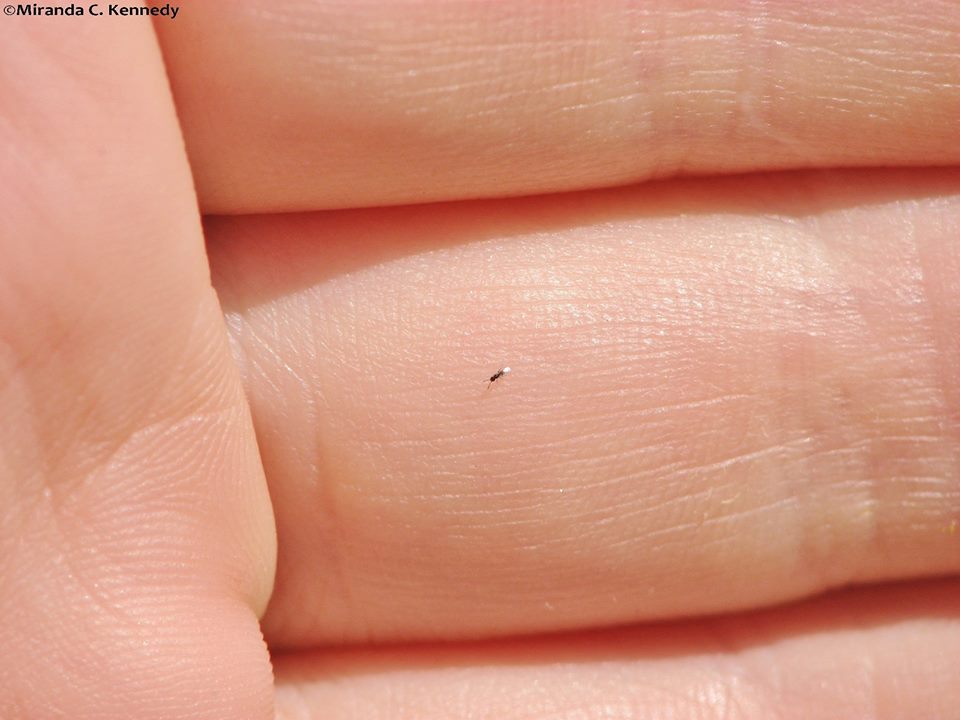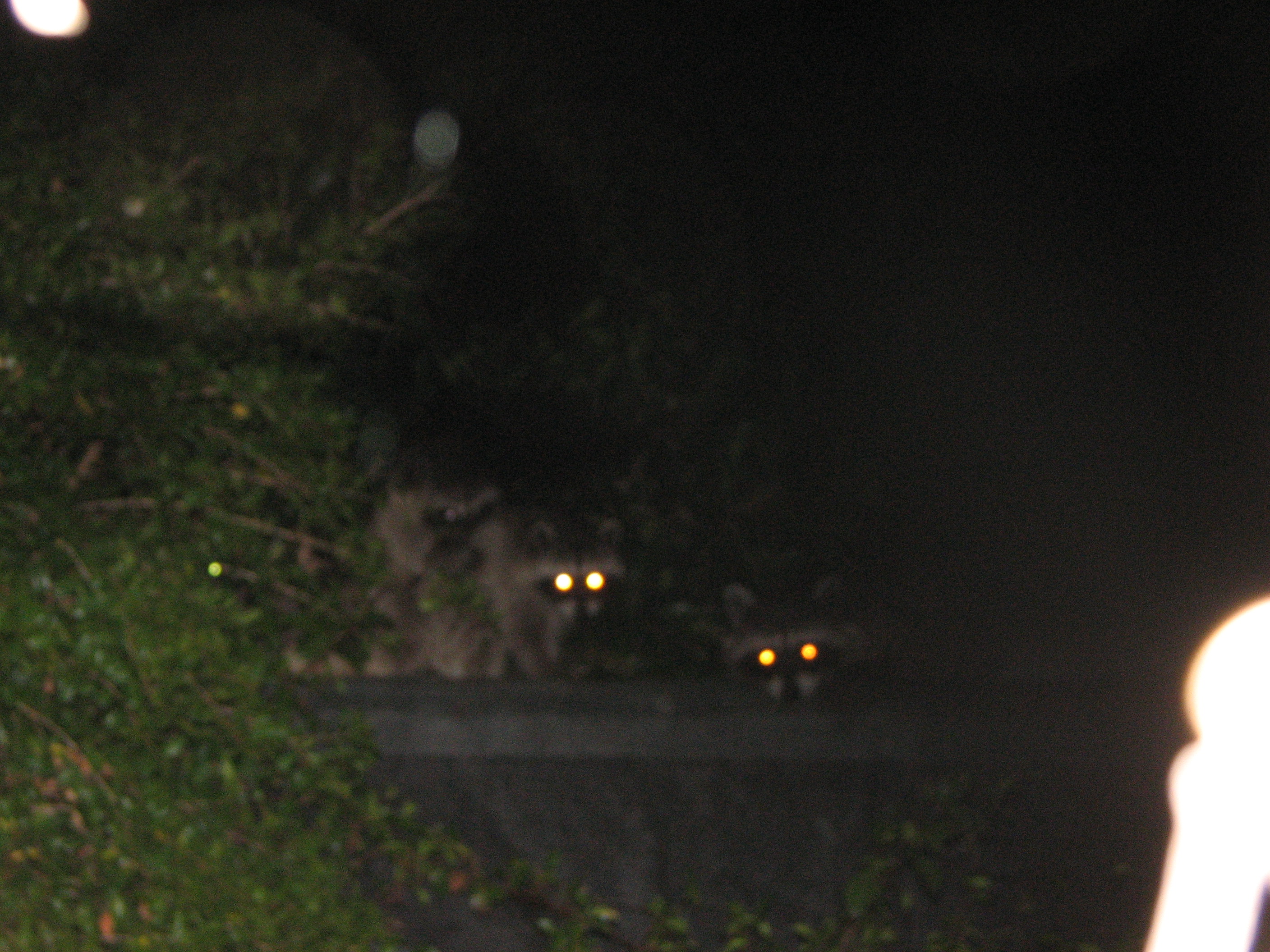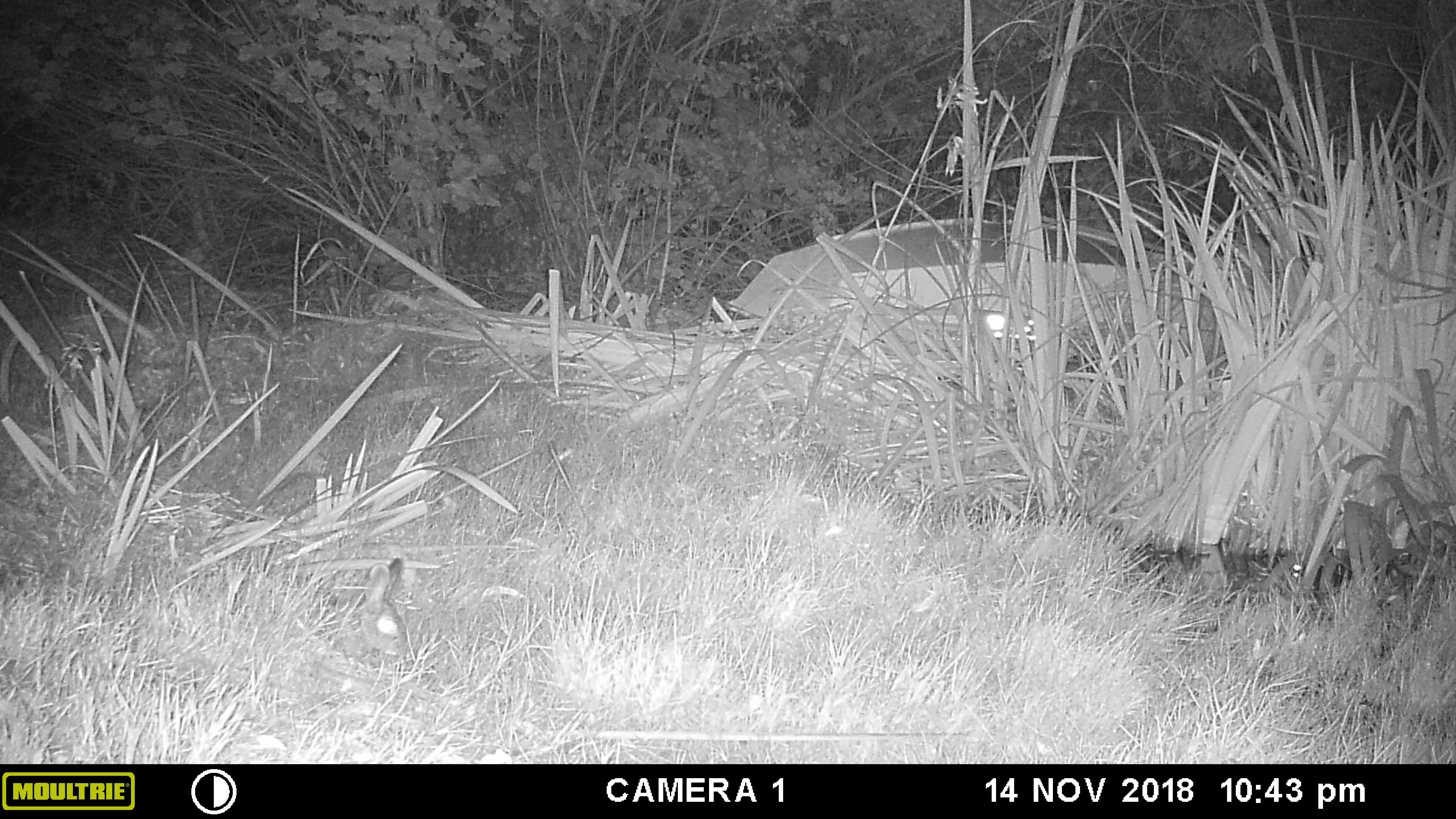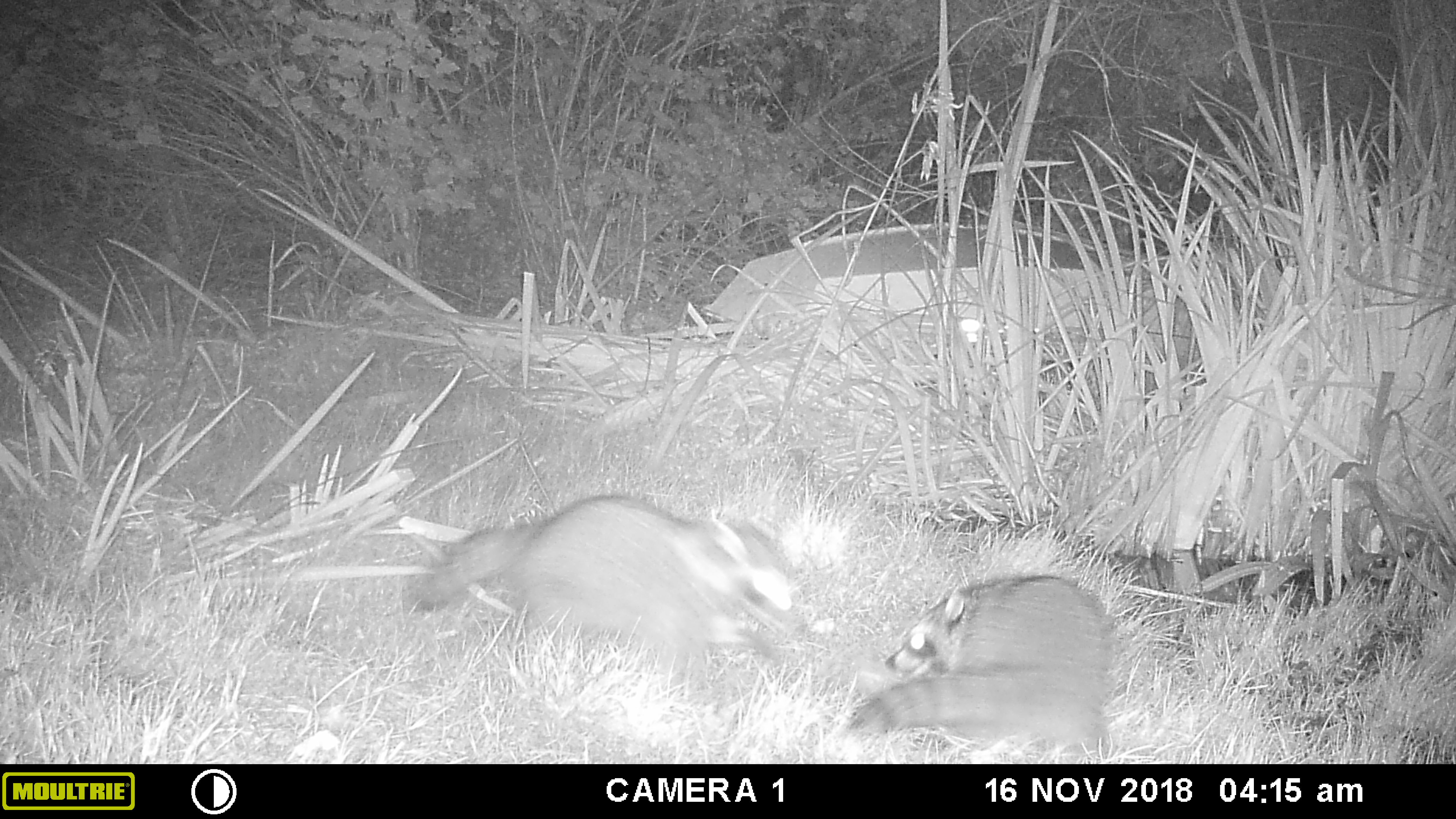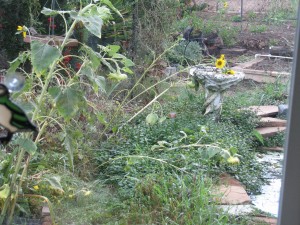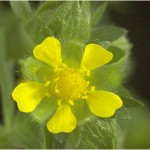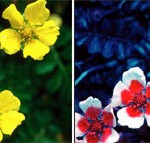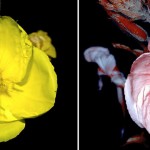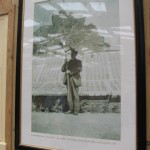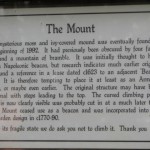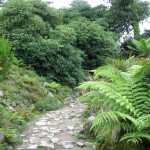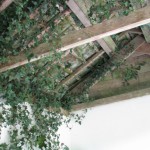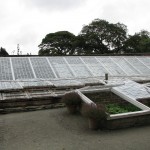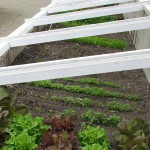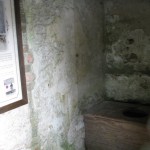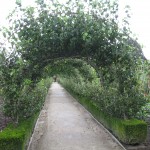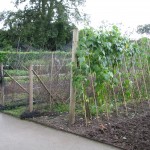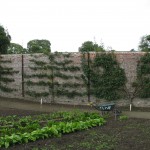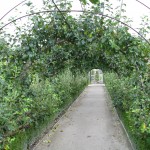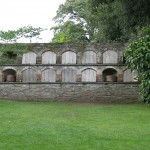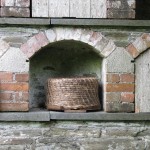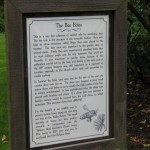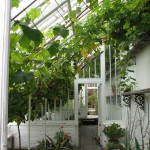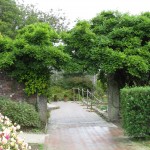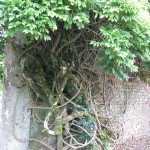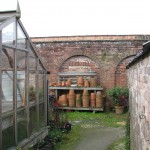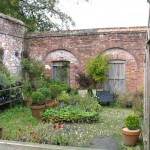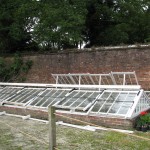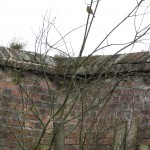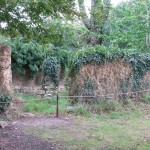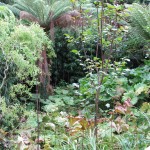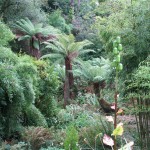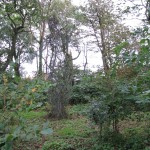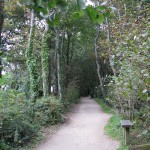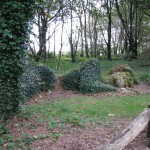Gardening adventures
Wrestling with the great outdoors.
- Gardening adventures, Permaculture and Edible Forest Gardening Adventures, Photos, Ponds, Rain Catching
The October Garden
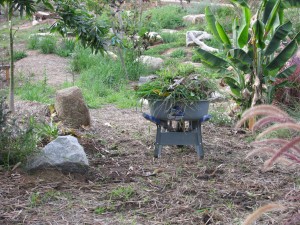
Weeding The weeds took advantage of the warm weather and my absence last week to really get some growing in. I’m pulling each weed by hand, shaking off the dirt (trying not to get showered with it in my eye), and composting them. The greens when layered with brown material (dead clippings, etc.) will cook nicely for use next year. I have a tall wire cage set up in one of the raised beds I haven’t filled yet, so the compost will be made right where it will be used.
Meanwhile the garden grows. Melon vines are dying, but the squash continues on!

Luffa vines grew up the palm trunks, then down again to the ground! With permaculture the idea is to mimic a forest dynamic, with lots of plants helping each other grow by providing elements other plants lack, such as nitrogen, mulch, shade, flowers to attract pollinators, etc. You can fit a lot of plants into a small area.
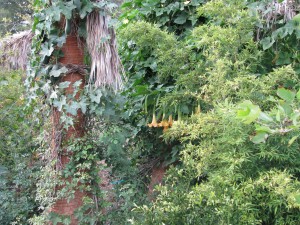
You can fit a lot of plants in a small space with adequate nutrients and water 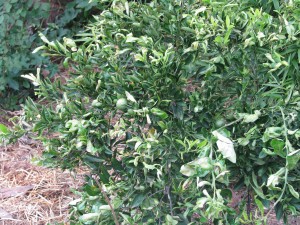
Trouble with citrus The orange tree above is receiving too much irrigation water due to its placement on sloping land and the nearness of water-loving plants. Planning beds with compatible plants providing adequate initial nutrition and water can result in happy masses of plants.

The palm walkway has become a jungle tunnel 
Bamboo and sugarcane 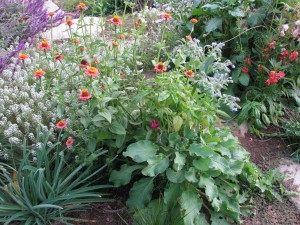
Bee and butterfly seed mix The pond, now six months old, looks as if it has been on the property for years.

The pond looking natural The melon vines and pumpkins have not only protected the land from the scorching summer sun, but will provide good compost and certainly are decorative as well as sources of food. I always wanted to wait for the Great Pumpkin!
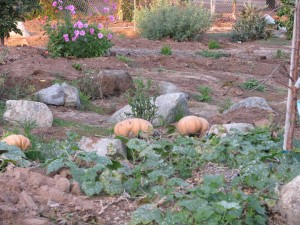
Cinderella pumpkins, with purple cosmos across the dry streambed Sages, mints and butterfly bushes continue to flower, providing much needed pollen sources for bees in this season of dearth.

The entranceway 
Bananas and sage Meanwhile in the vegetable garden many crops have had their day and I’m composting them as I get to them. Some such as the eggplant are still going strong. (See my steamed eggplant recipe! Yum!) .

Another giant eggplant hiding in the strawberries A garden as large as this can be overwhelming, especially in its first year. I’m trying to think in sections. I enjoy working the garden, making it mine and seeing the surprises that show up. My back and hands aren’t as happy, especially the morning after, but… too bad! “Get over it, guys!” I say, then realize I’m talking to my body parts. Alone in my garden, only the plants really care, and they aren’t looking. Or are they?
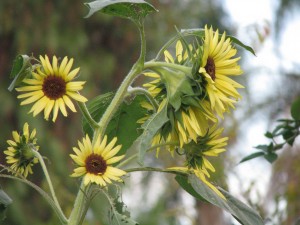
Sunflower keeping an eye out in all directions -
Freezing Apples
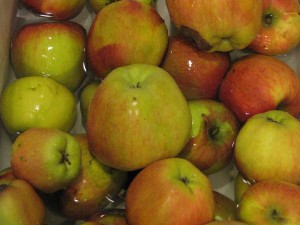 Growing your own food is marvelous. Having it all come ripe at the same time is not. My apple tree is producing well this year, and the apples need to be stored in some way. Since I don’t have a cold cellar, I need to can or freeze them. My plan was to can apple slices in either a light water and sugar mixture, or make Pie-In-A-Jar pie filling. However, two days of 101 degree heat took the wind out of my sails, and used up the time I had allotted for canning. The apples, however, are still there. So I froze them instead, which is probably the better solution because it doesn’t add any sweetener ahead of time.
Growing your own food is marvelous. Having it all come ripe at the same time is not. My apple tree is producing well this year, and the apples need to be stored in some way. Since I don’t have a cold cellar, I need to can or freeze them. My plan was to can apple slices in either a light water and sugar mixture, or make Pie-In-A-Jar pie filling. However, two days of 101 degree heat took the wind out of my sails, and used up the time I had allotted for canning. The apples, however, are still there. So I froze them instead, which is probably the better solution because it doesn’t add any sweetener ahead of time.Another good time saver if you are keeping apples for pies, is to make the apple pie filling, pour it into a pie pan and freeze it. After freezing, slip it out and into a freezer bag. When it comes time to bake, make the crust (which you actually can do ahead of time and freeze separately as well) and slip in the frozen pie filling. Add baking time.
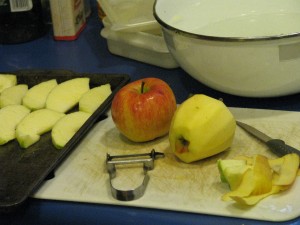
The best apple peeler I’ve ever had was purchased at the Del Mar Fair many years ago and given to me as a gift. It is easy to hold (I have arthritis) and I can zip through peel like nobody’s business. I know that design (in photo) is sold elsewhere, so don’t wait for the Fair.
Freezing ApplesAuthor: Diane KennedyRecipe type: Side dish or dessertPrep time:Total time:Freezing ripe apples allows you to have easy, ready-to-use apple slices whenever you want.Ingredients- Apples
- A bowl full of cold water
- A lime or lemon, or a teaspoon of apple cider vinegar
- cookie sheets that fit into your freezer
- Freezer bags
Instructions- Add the juice of a lime or small lemon, or the vinegar, to the bowl of water.
- Wash the apples.
- Peel several apples and drop them into the water to keep from browning.
- When bowl is full, slice apples into wedges that would be appropriate for pie, and drop the slices into the water.
- Place dipped slices onto a cookie sheet so that they don't overlap.
- Freeze cookie sheet with apples (about 20 - 30 minutes).
- Remove apples from sheet, place in marked freezer bag, flatten and squeeze out extra air, and place flat in freezer so that the bags can be stacked.
- Keeps for about a year.
-
Stuck Rat

I wasn't sure what I was seeing from the kitchen. Tree rats are part of life in a rural area. They have cost me hundreds of dollars in damage to my cars, since they love eating the tubing and enjoy the warmth inside for nesting. However they have their place… just not in my stuff. So when I looked out the window this morning while eating breakfast and saw a very un-birdlike creature in the hanging bird feeder, I had to go outside and see if it really was what I thought it was. Already the temperature was over 90 degrees in this heat wave, and it was only about 8 am.

Wood rats are one of three types found in San Diego County Rats don’t like the sun, being nocturnal, and the way this youngster was just hanging over the edge made me think he was ill. Then I thought that he looked as if he was stuck. I took a shovel and put the end up under his head, and he stirred, then gracefully stepped down on it and jumped off into the columbine. I think he was just a kid who had a bad case of the Where Am I?’s. I told him not to go into my cars. He did pose in a very picture-book fashion, becoming the most adorable rat I’ve ever seen.
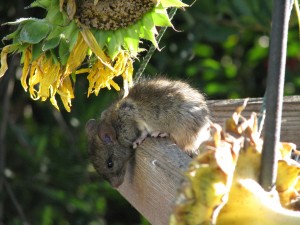
A long way down for a young animal. -
Heavenly Steamed Eggplant
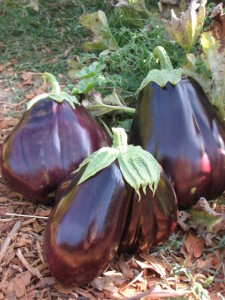
Black Beauty eggplant I love eggplant, but always thought it had to be salted, pressed and fried or baked. Cookbooks always talk about bitter juices that need to be leeched out. The recipe for Coucharas (see recipe list) calls for steaming eggplant until it is very soft so that the pulp can be mashed and combined with other ingredients.
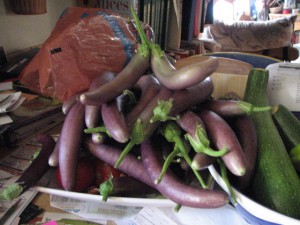
Japanese or Chinese (long) eggplants have few seeds Now with an abundance of eggplant, both Black Beauty and Japanese, in my garden, I looked for some simple eggplant recipes. Maybe everyone else in the world knows how incredible lightly steamed eggplant is, but I just found out!
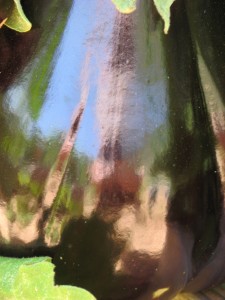
Choose glossy, firm eggplants I took a Black Beauty (globe) eggplant that I’d harvested the week before and was beginning to go soft, cut off the stem end and quartered it lengthwise. I steamed the slices for 8 minutes (no more than 10!).

Slice long eggplants into bite-sized chunks The texture was silky and smooth, not at all bitter and incredibly light. Over the top of the quarters I spooned a very easy sauce. The eggplant, which is notoriously spongy, soaked up the sauce. Slicing the eggplant, skin and all, was a dream and eating it was sublime.
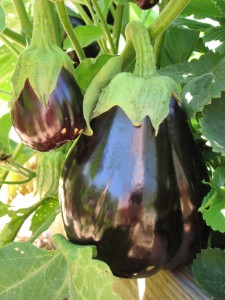
Eggplant is in the same family as tomatoes and potatoes It was so good in fact that I did the same with Japanese eggplant the next night, but instead of quartering them, I cut them into bite-sized chunks, then after steaming poured the sauce over them in a bowl and stirred them around to absorb the sauce. I served both with very thin noodles. Photos of cooked eggplant are rarely delicious-looking, so you’ll have to let your imagination guide you.
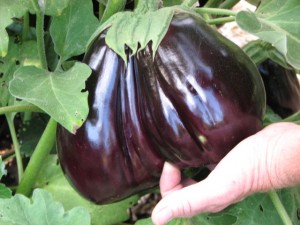
An enormous double eggplant! There are many sauce mixtures on the Internet, but here is mine:
Heavenly Steamed EggplantAuthor: Diane KennedyRecipe type: Main DishPrep time:Cook time:Total time:Serves: 2-4Quick, light, tasty, low-calorie and wonderfully different, this eggplant recipe is a gem.Ingredients- One large Black Beauty eggplant or 3 Japanese eggplants
- 2 Tablespoons Rice Wine Vinegar (or other mild vinegar)
- ⅛th cup Bragg's Amino Acids, Tamari Sauce or low-salt soy sauce
- ¼ teaspoon sesame oil
- 2 Tablespoons olive oil
- ½ teaspoon grated fresh ginger
- If you like garlic, dice or grate a small clove and add it in. You can also include chili paste to taste.
- Fresh cilantro (optional)
- Toasted sesame seeds (optonal)
Instructions- Cut stem end(s) off the eggplant
- If using one large eggplant, cut it into quarters long-wise from end-to-end. If using long eggplant, cut into ¾" - 1" bite-sized chunks. Do not peel.
- Steam eggplant for 8-10 minutes until a knife easily slides into the skin; do not overcook!
- Meanwhile, mix all sauce ingredients except cilantro or sesame seeds, if using.
- Plate the eggplant quarters and drizzle the sauce over the top slowly so it absorbs, or put chunks in bowl and mix with sauce, then plate. Offer extra sauce separately.
- Sprinkle with fresh, chopped cilantro and/or toasted sesame seeds.
- Very good with noodles or rice.
-
Mrs. Two Sheds
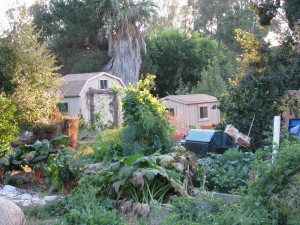
Two sheds seen through the veggie garden Since I had the other enormous and disintegrating sheds taken down last February, freeing up space and providing a lot of materials to recycle into other incarnations on the property, I have had no place to protect my tools. After much debate and shopping around I finally decided on Quality Sheds in Menifee. They build sheds right on the property in a day and cost far less than hiring a carpenter to do it. They offer a warranty on the materials as well.
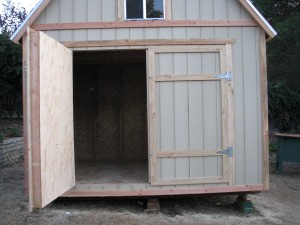
Tall Gambrel with double door In San Diego County you don’t need a building permit if the roof of the structure doesn’t exceed 120 square feet. I purchased a 10 x 12′ tall gambrel shed, with a loft and windows installed by popular window companies (more at Maverick Windows website), as well as a 6 x8′ potting and tool shed with a workbench. Not only did Quality sheds honor an outdated price sheet that I had, but gave me a discount for paying for two sheds and there was a 50% off sale on all ‘extras’ such as windows.

The loft I had these two sheds built for less than half of what a smaller area was bid me by a carpenter, and the large shed was $3,000 less than a bid for a smaller shed.
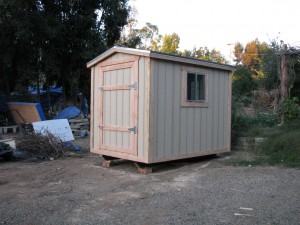
Potting Shed I still have to paint the sheds, and since the ground wasn’t level the sheds are propped up and to drive my mower in I’ll need to make a ramp.

Up on blocks 
A little precarious But finally! Somewhere handy to store my tools and to putter around in.

Workbench in potting shed Neither shed blocks a view, and they look natural where they are. Although I wish that the ground had been leveled when I had asked when the tractor was here digging the pond, because I’ll have to replace the stacked wood props with cement blocks at some point.
Can’t wait to paint and finish the sheds!

Sheds reflecting in the pond… how poetic! - Bees, Birding, Gardening adventures, Heirloom Plants, Other Insects, Permaculture and Edible Forest Gardening Adventures, Photos
Bouquets for Birds and Butterflies

Lilliput zinnia At the beginning of this summer, the new subterranean drip irrigation system was installed on my property. It features tubing with holes at either twelve or twenty-four inches apart. When it runs (from my well) it leaves circles of dampness polka-dotting the soil surface. I had purchased two packets of wildflower seed, one with a selection of plants to attract bees, and the other for butterflies. Mixing them together, I figured that they wouldn’t fare well scattered, at least this year. My daughter and I pressed seed into many of the wet spots and hoped the rabbits wouldn’t notice.
What happened was a delightful surprise, as only a garden can provide. In many locations around the yard grew mixed bouquets of wildflowers.

Mexican sunflower, cosmos, nasturtiums, zinnias, surround a white calla lily If we had separated selected seed and planned the planting, nothing so beautiful would have come of it. Although many species either didn’t emerge or were eaten, the most common survivors were zinnias, cosmos and borage.

Cosmos, borage, zinnias and alyssum. I was amazed and thrilled; I had purchased a borage plant and then fed it to the rabbits (at least, that is what they thought). Here now are borage plants all over the yard, their royal blue, cucumber-flavored flowers dipping modestly behind the flaunting cosmos.
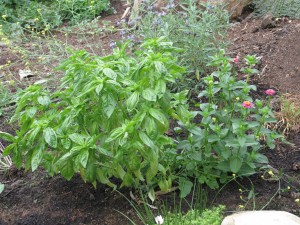
Sweet basil, cilantro, dill and zinnias In fact, I now have several very hearty sweet basil plants that put the carefully cultivated plants in my raised veggie beds to shame. There is also dill and cilantro growing well even this late in the season.

Cosmos, sweet basil, zinnias, borage, camellia balsam, alyssum There are some plants in the bouquets that haven’t reached maturity yet, so there may still be some surprises. The only flower that emerged that I didn’t recognize and had to look up was camellia balsam (Impatiens balsamina). Two stalks of it, one pink and one red, give these ‘arrangements’ a vertical line.

Camellia balsam (Impatiens balsamina) Although not all of these wildflowers are native to San Diego, or even California, they provide food for birds, bees and are host plants for butterflies, providing the caterpillars food, a place to form their chrysalises, and nectar for the mature butterfly. Bees like small flowers with little drops of nectar too small to drown in, with a nice landing pad of a petal close by. Everything in the carrot family works well. Here are some suggested flowers to plant:
For butterflies:
Mexican lupine, Mexican sunflower, borage, calendula, camellia balsam, scabiosa, cornflower, milkweed, parsley, crimson clover, aster, coreopsis, cosmos, prairie gayfeather, purple coneflower, sweet sultan, sneezeweed, sweet William, bishops flower, black-eyed Susan, dill, snapdragon, yarrow, bergamot, cleome, verbena, and butterfly bush.
For bees:
Cosmos, sunflowers, borage, coriander, Siberian wallflower, dill, coreopsis, poppies, gaillardia, zinnia, sweet basil, purple prairie clover, globe gillia, catnip, lemon mint, black-eyed Susan, goldenrod, lavender hyssop, bergamot, yarrow, mint, California buckwheat.
Be sure to plant flowers that bees love away from paths and walkways if you or your family want to avoid contact with the bees.
-
Oh, Whatta Night
-
First Rain
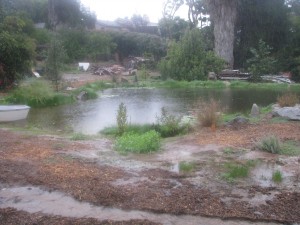
Rainfall on the pond The first week of October and we’re having a day of heavy rain… almost unbelievable. Normally October in San Diego is high fire season. The brush is crisp from months of drought and high temperatures, and then the Santa Ana winds begin: wild dry winds that blow east to west from the deserts, full of static and mad gusts that turn brush fires into firestorms.
My property is a watershed, funneling rainwater from the street through to the streambed in the barranca below, taking all my topsoil and some of the embankment with it. This year I had the beginnings of a permaculture garden installed to remedy this pattern. By deepening the loam and placing berms around plant guilds water is encouraged to pool up and soak in rather than run off. Overflow is channeled through a series of dry ponds which allow water to soak into the ground. From there it is channeled safely down to an overflow into the stream. Today was an early test of what has been worked on since Feb. 1.
The tilling, mulching and berming done by the crew of landscape architect Roger Boddaert proved successful.
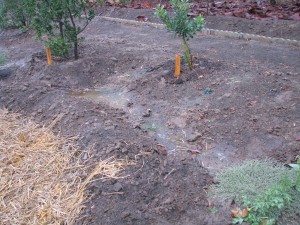
Berms hold water back so that it may soak into the loam The soil has a high clay content, which was good news when digging the large pond because it held water without a liner. It is bad news for other areas of the garden where water is pooling up instead of sinking in. I was able to take note of these areas this afternoon so that they could be drained and mulched for more absorption.
Aquascape, the company that installed the series of ponds, is still planting and maintaining the waterways. Jacob came out in the rain and watched it flow, shaping and fortifying as the force of the rain and thus the volume increased.

Jacob helping water flow Water flowed under the fence from the street, but instead of flooding a cement culvert as it used to do, it is channeled down to the ponds.
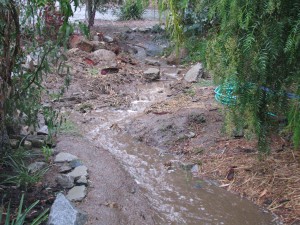
Street run-off enters under the fence 
Blocked by debris, water floods past the bridge Silt and debris blocked water flow under the bridge, and was eroding the area by the structure called the Nest. I cleared the debris and raked rocks and silt to the weak side, and that fixed the problem temporarily.
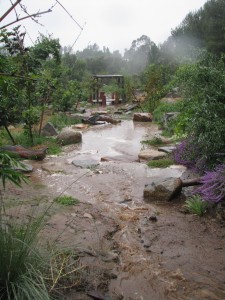
Rainwater flowing into the first 'dry' pond Water quickly filled the first dry pond; with the high clay content, water percolates but does it slowly.
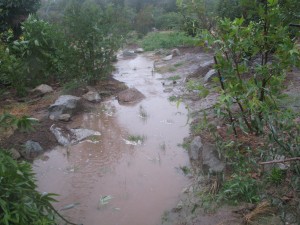
'Dry' ponds filling and slowing run-off 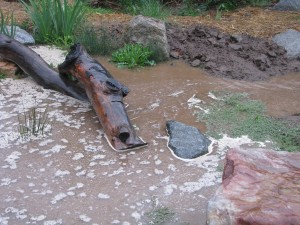
Logs and rocks are ornamental and slow water flow 
Normally dry, the stone crossing is now almost underwater 
The little pond is rapidly filled. As water reached the small pond, which wasn’t intended to permanently hold water but the clay had a different idea, the sides had to be shored up and the overflow diverted.

Water is diverted from the little pond around the big one Extra floodwaters aren’t being diverted into the large pond because we don’t want it filled with silt, and we don’t want it overflowing rapidly and eroding the sides. Instead the water flows through a channel around the large pond, then down to a prescribed place to flow out and over the embankment to the stream below.

Overflow is channelled past the ponds and out to the natural stream below Some areas of heavy erosion had been filled and supported, and as of six this evening they looked wet but not iffy. What a night of heavy rain will do, I’ll have to see in the morning. I am very lucky to have this type of
rain early in the season. It has been heavy enough to cause significant water flow to help shape the watercourse and show weak spots, and the rain will be reduced to showers tomorrow then clear up, so repairs and improvements can be made before true flooding happens later in the year or early in the next.Although much more water is being held on the property, and topsoil is not being lost, it still pains me to see so much rain channeled out to the stream. Rainwater is a neutral Ph, and carries nitrogen (especially when
there is lightning). It is the best possible water for plants, as well as for human consumption and bathing. In side-by-side comparisons with tap water, plants watered with rainwater flourish far beyond the growth of the others. I’m greedy to hold that water onto my property, letting it soak as deeply as possible for tree roots to use far into the year. As the newly planted trees grow, their roots will help hold water and soil. As their leaves drop the mulch levels will raise, aided by compost and mulch that I will be constantly adding, and the soil will become more absorbent farther down. Each rain should have less runoff and more absorption. This rain has shown a great success with the garden, but I know it is only the beginning. - Animals, Bees, Gardening adventures, Heirloom Plants, Other Insects, Permaculture and Edible Forest Gardening Adventures, Vegetables
What Bugs See
To veer off from the vacation photos, I thought I’d talk about bugs! I’ve been working in the garden a lot and watching the myriad types of insects drawn to the various flowers blooming all over, and it reminded me of something amazing that I learned last year. The way flowers look to us is not what most insects and birds see. The flowers are bright and showy, but they offer up visual clues to pollinators through colors and patterns that can only be seen with eyes that see UV light. Humans can’t. We can’t assign colors to UV light in the way that we understand them, so when photographing with UV light we substitute our colors to show the change in patterns. The markings on the flowers are guides to where the pollen is, like lights and painted lines on airport runways. Just as baby chicks’ mouths are large and brightly colored to show mom and dad where to put the worm, especially on the inside as they gape and wait to be fed, so have flowers made sure that the pollinators get to the right place for pollen! The differences between what we see and what insects see can be startling; there is a whole hidden world right before our eyes, just as there are supersonic and subsonic sounds that we cannot hear. Elephants make subsonic noises that other elephants can hear miles away, but we aren’t aware of it.
Below are photos taken with and without UV light by the brilliant Norwegian scientist-cameraman Bjorn Roslett. Remember that the UV colorization is man-made to show the difference in patterns. More technical information can be found at his site here: http://www.naturfotograf.com/UV_flowers_list.html , with lists of types of flowers and what approximate color changes there are under UV light.
Dandelion Vinca minor Vinca minor under UV Norsk mure (Potentilla norvegica) Norsk mure under UV Primrose Crocus Anemone -
The Lost Gardens of Heligan
If you ever go to England, go to Cornwall and spend at least a day at the Lost Gardens of Heligan (http://www.heligan.com/ ). Due to a flat tire we only spent four hours there and we didn’t see even half of the 400 acres of incredible restored gardens. The story is this: a thousand acres on the southern coast of Cornwall has belonged to the Tremayne family for about 400 years. At the end of the 1800’s, one of the Tremaynes had built extensive theme gardens. There were walled gardens, enormous hedges, glass houses, cold frames, a pineapple pit where the only pineapple grown in Cornwall grew warmed by horse manure. Melon houses, leisure gardens, formal flower gardens, woods, kitchen gardens and unbelievably, tropical gardens, filled the estate. Due to Cornwall’s position by the English Channel the climate is such that with care tropicals can be grown there. The estate was fantastic; then came WW I, and almost half the family and staff were killed. The gardens were abandoned. Subsequent wars and taxes took their toll, and the gardens became overgrown. Vines, brambles, trees and weeds ran rampant, breaking through the glass roofs, pulling apart brick walls, upsetting carefully laid pathways and covering every trace of the gardens under a head-high blanket of tangled, thorny brush.
Twenty-one years ago, the Tremayne who inheirited the gardens, asked one of the founders of the neighboring Eden Project ( http://www.edenproject.com/ ) to try and restore the gardens. The task was phenomenal and reads like a mystery. Hacking through the overgrowth they found the walls, the foundations and the clues as to what had been. Since then the gardens have been restored. They are everyone’s dream of a garden combined. There is a mound that was a beacon mound during Nepolianic times, but then discovered dates back to the Armada, and then back to Medieval times! There is a jungle with massive gunnera plants and palm trees, about half an acre of vegetables all grown from seed that dates from the late Victorian time, walled flower gardens, ‘antique’ poultry and cattle, unique sculptures recently added, and a wildlife garden to encourage the existence of so many insects, birds and animals that are disappearing. Even with weeding through photos I came up with so many that I want to share, that I’ll just post them below. Visit the website and read up on the Lost Gardens, voted Britain’s Finest Gardens. They are magical.
Entrance to a magical world. The Tremayne who built the gardens holding a single Gunnera leaf in front of his famous pineapple pit. Flavors of ice cream… we didn’t get to have any! A mysterious mound was uncovered and thought to have been a beacon site in Nepolianic times, and for centuries beyond that. Stone steps into the ravine The Italian garden Ivy coming through the roof, trying to reclaim the building once again. Hot houses and cold frames Cold frames for veg. Espaliered pears of many varieties. Writing on the wall of the ‘thunder room’, or original composting toilet All plants and veg grown are from the late Victorian period Espaliered fruit trees make use of warm wall space About a quarter acre of mixed greens. Bee skeps (baskets, pre-movable hives) were kept in boles for winter protection. A bee skep in a bee bole History of the Bee Boles A banana grows in Cornwall! Melon houses Potting shed with greenhouses in a walled area. Sigh. Cold frames in the potting shed A robin watches, just like in The Secret Garden The overgrown remains of mud brick walls A very steep pathway lined with chicken wire to prevent slipping The Jungle A wire sculpture of a woman with her arms out… can you see her? A deciduous walkway Mud Woman A very green man
